Chupacabras Solution: Neither New Species, Nor Silly
Posted by: Loren Coleman on May 21st, 2010
Chupacabras Solution: Neither New Species, Nor Silly
by Loren Coleman
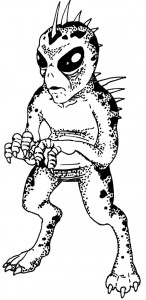
Ben Radford, the managing editor of Skeptical Inquirer, appears to have made a major breakthrough regarding Chupacabras, after all. Radford, it can be told, has identified a precise popular foundation to the explosive beginnings for the widespread interest in Chupacabras beginning in 1995.
As is well known to readers of Cryptomundo, Radford is the author of a “detailed and exhaustive”
book on Chupacabras, due in 2011, from the University of New Mexico Press. He has already spoken often of how his revelations will solve the Hispanic mystery of these creatures.
Ben Radford has now jumped his own game of anticipation, and has given away the end of his story. In a just-published new book entitled Scientific Paranormal Investigation: How to Solve Unexplained Mysteries (Corrales, NM: Rhombus, 2010), Radford spills all his Puerto Rican beans.
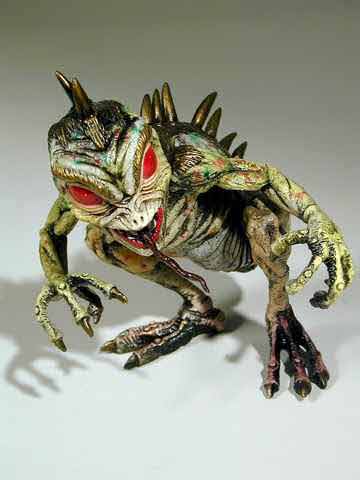
Indeed, Radford writes in this new book that due to his investigation, the “chupacabra mystery crumbled and the solution was complete.”
What does Radford say was behind the outpouring of interest in the Chupacabras? Radford points to a less-than-credible eyewitness who, he says, appears to have mixed a movie’s impact with her sighting descriptions of one of the first widely-reported Chupacabras cases. Radford blames the Chupacabras, as we know it today, on the movie Species’
shape-shifting humanoid creature, Sil.
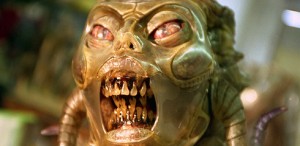
Radford writes (pp. 297-298):
“A young woman named Madelyne Tolentino of Puerto Rico gave the most important chupacabra description on record, not only because of its remarkable detail but also because it is the ‘original’
description upon which almost all images of the creature are based.
“Tolentino claims that she saw the creature near the street from her mother’s house during the second week of August, 1995.”
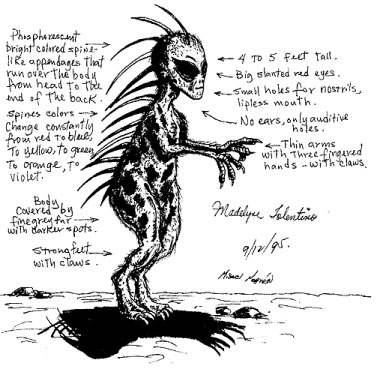
Radford is clearly correct in this regard, and the drawing made based on Tolentino’s sighting, was the one that was used over and over by the media, book illustrators, and investigators.
Radford goes on (p. 298), after doing a little reading on the case, to find that “this ‘eyewitness account’ is riddled with implausible observations, contradictions, and inconsistencies….There was not a shred of evidence to support Tolentino’s incredible story…Yet…her description became the ‘standard’ chupacabra image known worldwide.”
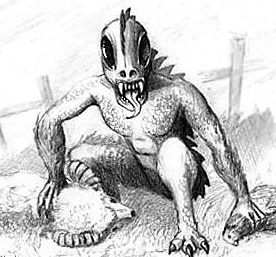
Looking for a missing piece of his puzzle to “solve”
the Chupacabras mystery, Radford found what he was looking for.
“Just before Tolentino’s sighting, a new element was added to the island’s social and cultural mix –
something that had not existed there before and could have spawned chupacabra sightings. The creature Tolentino described bears no resemblance to any known animal. It does, however, look almost exactly like a fictional creature seen by hundreds of thousands of people in 1995: Sil.
“Sil is the name of the alien creature played by Natasha Henstridge in the science-fiction horror film Species. Species was released in Puerto Rico on July 7, 1995 – less than a month before Tolentino reported her chupacabra sighting. The creatures looked very similar; could the original chupacabra eyewitness have simply described a monster she saw in a movie? It’s certainly possible,”
says Radford, (p. 300).
One of the most damning pieces of evidence for Radford was found in investigator Scott Corrales’ 1997 book, Chupacabras and Other Mysteries. In Corrales’ text, it is noted that Tolentino made the connection between Sil and the Chupacabras herself. Tolentino told an interviewer that she had seen a “movie called Species…
.The movie begins here in Puerto Rico, at the Arecibo observatory.”

Tolentino’s comparison between the Chupacabras creature she had seen and the one in the movie is mentioned in Corrales’ book, when she notes the movie monster “was a creature that looked like the chupacabra, with spines on its back and all….The resemblance to the chupacabra was really impressive….I watched the movie and wondered, ‘My God! How can they make a movie like that, when these things are happening in Puerto Rico?”
An interviewer asked Tolentino in Puerto Rico, in 1996, Corrales noted: “In other words, does [Species] make you think there might have been an experiment in which a being escaped and is now at large?”
Tolentino answered: “Yes.”
Radford then writes (p. 302): “Thus it seem [sic] that Tolentino believed that the creature and the events she saw in Species were actually happening in reality in Puerto Rico at the time.” [Emphasis is Radford’
s]
I wonder if Radford’
s chronology is a bit off? But let me return to that in a moment.
He writes, “Remember, Species was seen by the Puerto Rican public at the exact same [sic] time that the chupacabra hysteria occurred. This confusion between fact and fiction, reality and fantasy, says much about her credibility.”
Ben Radford makes no bones about what his conclusion is (p. 302): “The popular image of the chupacabra – the one appearing on thousands of books, magazines, and Web sites as a credible eyewitness description – is in fact based on a science fiction film.”
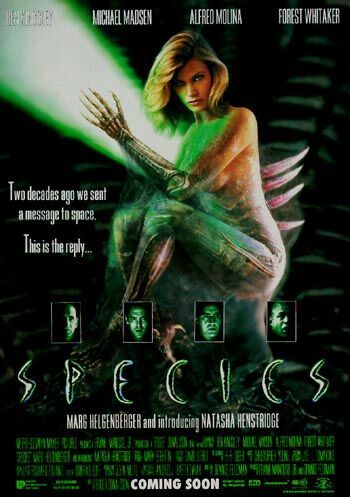
Okay, a few agreements and cautions need to be added to the end here.
Ben Radford’s conclusions before this Sil business that he shares in his Chupacabras summary in his new book are hardly earthshaking. Although he does not clearly state it, he seems to be in agreement with cryptozoologists who have found little of worth in all the findings of dead dogs, recovered mangy coyotes, and photographed less-than-cryptid canids with and without mange that have been labeled “chupacabra”
in recent years.
While Radford acknowledges that livestock killings were discovered in the months before the Tolentino sighting, there is no direct link between them and any reported Chupacabras.
I must congratulate Radford for his discovery and linkages, in images, popular cultural impact, and the copycat effect, between the Tolentino sketches and the appearance of Sil from Species.
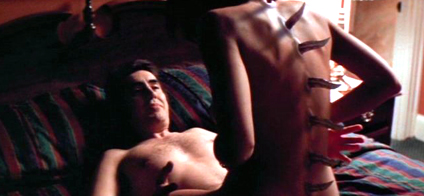
I can only imagine that those viewing Species were distracted by Natasha Henstridge, and missed that her changed form had a striking resemblance to the Chupacabras in the news a few months later. (This is not to be taken as a serious excuse on my part, and is merely a poor attempt at humor. Do excuse me for the momentary respite in this otherwise serious study of a worldwide phenomenon and Ben’s theory.)

I am left with some questions, not to debunk Radford, but merely to understand his revelation a bit more.
Did Tolentino see Species before her sighting (as Radford seems to be implying), or could she have seen the film after her alleged encounter, only then making the comparison from that frame of reference, as the Corrales book seems to be saying?
This is a valid point to explore. I have often interviewed eyewitnesses who are so traumatized by their observations and experiences that part of their psychological process is to find an anchor, a popular cultural framework or familiar image to make their event “feel” more “real.”
This is sometimes done with fictional characters too, as what they saw was so weird and remarkable that even fictional sources are searched to try to point to as similar to what it was they sighted. For example, this happened with the media commentary, after the Dover Demon 1977 case, when references to drawings of the Golem in The Hobbit and The Lord of the Rings were made.
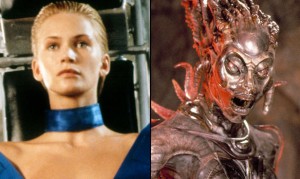
What if Tolentino only saw the movie Species after her sighting, and then made the link, which was only revealed in a 1996 interview, a year later?
I do congratulate Radford for his detective work, but I think he would agree that if his solution is a “fact,”
as he states, it will stand the test of further investigation itself.
There are other historic points I’
ve chronicled in my book, Cryptozoology A to Z and here on Cryptomundo that need addressing.
The real explosion of the Chupacabras phenomenon only took place after there was a segment broadcast on the Spanish Univision program Christina, a popular show not unlike the English-speaking program at the time headed by Oprah Winfrey. That happened in March 1996, long after Species opened in Puerto Rico in July 1995, and the Tolentino sighting in August 1995. How does that figure into Radford’s theory and Tolentino’s statements?
Furthermore, how does Radford explain the longer history of Chupacabras discovered by Corrales and myself, such as the first mention of Chupacabras on television, on “Bonzana”
in 1960, of creatures that sucked milk from goats?
Good for Benjamin Radford, I say, nevertheless. Now let’
s discuss what we think of his findings, not perhaps a final solution but at least a workable theory, as he has presented it.
It is not silly, and we have to now review what Sil’s influence may have been during the dawn of the modern Chupacabras era.
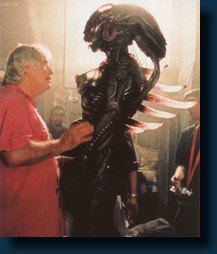
About Loren Coleman
Loren Coleman is one of the world’s leading cryptozoologists, some say “the” leading living cryptozoologist. Certainly, he is acknowledged as the current living American researcher and writer who has most popularized cryptozoology in the late 20th and early 21st centuries.
Starting his fieldwork and investigations in 1960, after traveling and trekking extensively in pursuit of cryptozoological mysteries, Coleman began writing to share his experiences in 1969. An honorary member of Ivan T. Sanderson’s Society for the Investigation of the Unexplained in the 1970s, Coleman has been bestowed with similar honorary memberships of the North Idaho College Cryptozoology Club in 1983, and in subsequent years, that of the British Columbia Scientific Cryptozoology Club, CryptoSafari International, and other international organizations. He was also a Life Member and Benefactor of the International Society of Cryptozoology (now-defunct).
Loren Coleman’s daily blog, as a member of the Cryptomundo Team, served as an ongoing avenue of communication for the ever-growing body of cryptozoo news from 2005 through 2013. He returned as an infrequent contributor beginning Halloween week of 2015.
Coleman is the founder in 2003, and current director of the International Cryptozoology Museum in Portland, Maine.










That is an interesting correlation–but as you said, Loren, there are a lot of variables involved, and while the movie may have influenced Tolentino’s image of whatever she saw (depending on which came first–her sighting or the movie), it still doesn’t mean she didn’t see something bipedal that looked similar to Sil–unless he’s claiming she hallucinated the entire thing.
However, I remember seeing a show about the Chupacabras–it was actually an episode of Unsolved Mysteries, and they interviewed a police man who had encountered a “chupacabras” on a deserted road. It passed in front of his stopped car in the headlights and he gave a very similar description of the creature in terms of bipedal, long fingers, and the spines off the back. And other witnesses claimed to have seen it rise up on two legs.
So, while I can see that maybe a movie influenced description details, it doesn’t explain the reports of a bipedal creature being seen–only that the mass image has been shaped or distorted by a popular movie at the time…obviuosly I haven’t read Radford’s book, but he’d have to answer those questions in order for me to buy in.
Potential Scenario:
Science-fiction altering human experiences, or at least the way humans describe circumstances they may or may not have encountered.
To exclaim all “Chupacabra” reports are based around this single movie is a very interesting argument, although to accept that argument would in fact be turning a back to any reality of these events. Science-fiction and science-fact have a very thin border between them. Considering the “movie effect” I believe witnesses to better grasp sympathy of those listening to them have linked features in connection to the creature from the film above, in terms of appearance, as to enable the person they are confiding this to better visualize the situation. Once a movie comes out and more people goes to see it, it becomes a symbol for whatever it is about. An example of this would be aliens being connected to the film “E.T.” even though sightings existed before the film was released. The “movie-effect” therefore is likely not an explanation for these events but a means of communication to share these experiences. There could be no such thing as a “Chupacabra” but to stop believing encounters locals in Puerto Rico and elsewhere have had, would not be true science, as observation and an open mind precedes drawing conclusions when the metaphorical water is still murky.
Wish I could remember where I saw it but I’m almost sure I read something that mentioned chupbacabras being reported in the 1930’s. It sure wouldn’t be the first time somebody used something from little known literature in a movie and it suddenly became well-known.
As a longtime reader of this blog, I know the people here have an appreciation for good looking ladies, but really… Can you keep it family friendly? I often discuss cryptozoology with my young friends and point them to different articles here. Not something I’m too inclined to do anymore…
Don’t wish to sound complaining. I know a blog is a lot of hard work and I appreciate the great posts. But really… don’t see how that photo really adds to the discussion here.
Yes, well, I could go on and on about the validity of the argument and that perhaps seeing the movie influenced the sighting or in any way vicea versa, ambiguously, of course.
But I would like to just say thanks for the distracting photos, it really made the whole post worthwhile! Afterall, who doesn’t like pictures with their text?
Nice.
As you are well aware, I try to keep away from all these debates, but to pin the entire narrative of the chupacabras (yes, with an “s’) on a single set of witnesses (Ms. Tolentino and her husband) is to deny the hundreds of eyewitness accounts from all over Puerto Rico at the time that described the same creature. Not a dog, not a feral ape, not “a lion” as a caller to one of the late-night show was moved to say: it was an entity as drawn by Jorge Martín based on the Tolentino account, issuing a very strong chemical odor, and with very curious physical properties. In retrospect, the Sanchez eyewitness account — the man who struck the creature with a machete to no effect — stands out as the most realistic and sobering. This was a religious man who wanted no part of the experience, and whose fellow church members broke into loud song to interfere with the interview. Skeptics overlook the fact that the most dramatic manifestations of the creature occurred not in Puerto Rico or Mexico or indeed anywhere in the Caribbean basin, but in Brazil and later on in Chile. Whether its an unknown physical creature or a paranormal “visitor”, the Chupacabras transcends the pages of any single book.
Interesting theories and info!
Speaking of Chupacabras, check this out.
If someone sees something that knocks them for six and they feel compelled to communicate this to others, the first thing they usually try to get across is how unusual their experience was, “like nothing I’ve ever seen before, like nothing I’ve ever experienced”.
The moment they’ve established that idea, however, they immediately start looking for analogies to convey at least some impression of what they’ve undergone, what they’ve seen, i.e., they’re forced to use the known to describe the unknown.
Hence Kenneth Arnold spoke of the unusual flying behaviour of whatever it was he witnessed as being like a saucer skipping across water and others, using this idea of the ‘flying saucer’ as a kind of shorthand, happily opined they’d seen a ‘flying saucer’ too, even though they’d often be describing ‘flying cigars’, ‘flying domes’, ‘flying doughnuts’, etc., etc.
It’s the same with the term UFO – by definition, something UNIDENTIFIED – yet people generally use the terms UFO and flying saucer as if they’re exactly interchangeable.
I love this idea, though, of pop culture explaining away all these weird and wacky people who apparently only need to read the term ‘grey’ in newspapers to set them off imagining they’re being kidnapped by aliens, or watch a Sci fi movie to start hallucinating chupacabras, (although it begs the question if she saw a movie ALIEN why didn’t she instantly assume what she was seeing outside the movie theatre was ALSO an alien?).
I remember having a conversation with a police officer mate who ended up drinking himself to death because he couldn’t handle his weird experiences, (it’s why I refer to myself as a theosexual as a pun on homosexual, since once upon a time medication, lobotomies and electroshock therapy were all used on homosexuals in an attempt to ‘cure’ them, too).
He was having one of his cynical days when he was trying to explain away our mutual tendency to undergo episodes where time seems to slow down or even come to a dead stop. Apparently, according to him, it was all down to the influence of the movie The Matrix; and I had to admit, it was a plausible explanation – until you realised The Matrix was released at the end of the ’90s, whereas we’d first spoken about our experiences at the beginning of the ’90s.
According to this cultural precedent explanation, then, when people claim to’ve seen the likes of David Bowie, Michael Jackson, Madonna and Lady Gaga on tour, they’ve all been hallucinating.
What’s really happened is all of these imaginary figures are celebrated for supposedly performing in strange ostentatious outfits and executing weird gyrations on stage, all motifs of the career of Elvis from Jail House Rock through to Vegas.
And there’re Elvis fans who’ll tell you for a damned fact there’s only ever been Elvis!
(I’m a Bowie fan, by the way).
thank you Loren for bringing some sanity to the topic of
goat-suckers…
and btw Remobec, maybe it’s time for you to start playing with
‘friends’ your own age…
As anyone who has eagerly anticipated the release of a new film in Puerto Rico can attest, sometimes you have to wait a lot longer than you would stateside. It’s hit or miss when a new release will show up in Puerto Rico. Sometimes it can be opening weekend, other times it can be much later. Food for thought.
It is rubbish what Ben Radford, the managing editor of Skeptical Inquirer, writes!
In a documentairy of Arthur C. Clarke’s Mysterious World there was a policeman (?) who shot at a Chupacabras when the Chupacabras was on his property. The Chupacabras rolled over and flew away. You can see the documentairies of Arthur C. Clarke’s Mysterious World on YouTube. Some people are uploading all the A C Clarke’s documentaries on YouTube.
awrvb responds: “It is rubbish what Ben Radford writes!”
My apologies, awrvb.
I have only spent a decade investigating cryptozoological mysteries, doing first-hand field investigations into these topics, and writing columns, articles, and books on the chupacabra and other mystery animals.
You, after having seen part of an old TV show on YouTube, are clearly far better informed than I am about the chupacabra.
I was checking out the website for Caribbean Cinemas of Puerto Rico, which is currently the only major chain (at least according to Wikipedia). I noticed that their release dates are a couple of weeks behind.
Mr. Radford, are you certain that ‘Species’ was released in PR on the same date as it’s proper US release? Because we are talking about 5 weeks between a film’s premiere, and Ms. Tolentino’s description, and when dealing with such a short window, it’s probably a good idea to be certain.
Just because a film is released on July 7th doesn’t mean that it’s going to be shown at your local theatre in West Nowhere, Idaho.